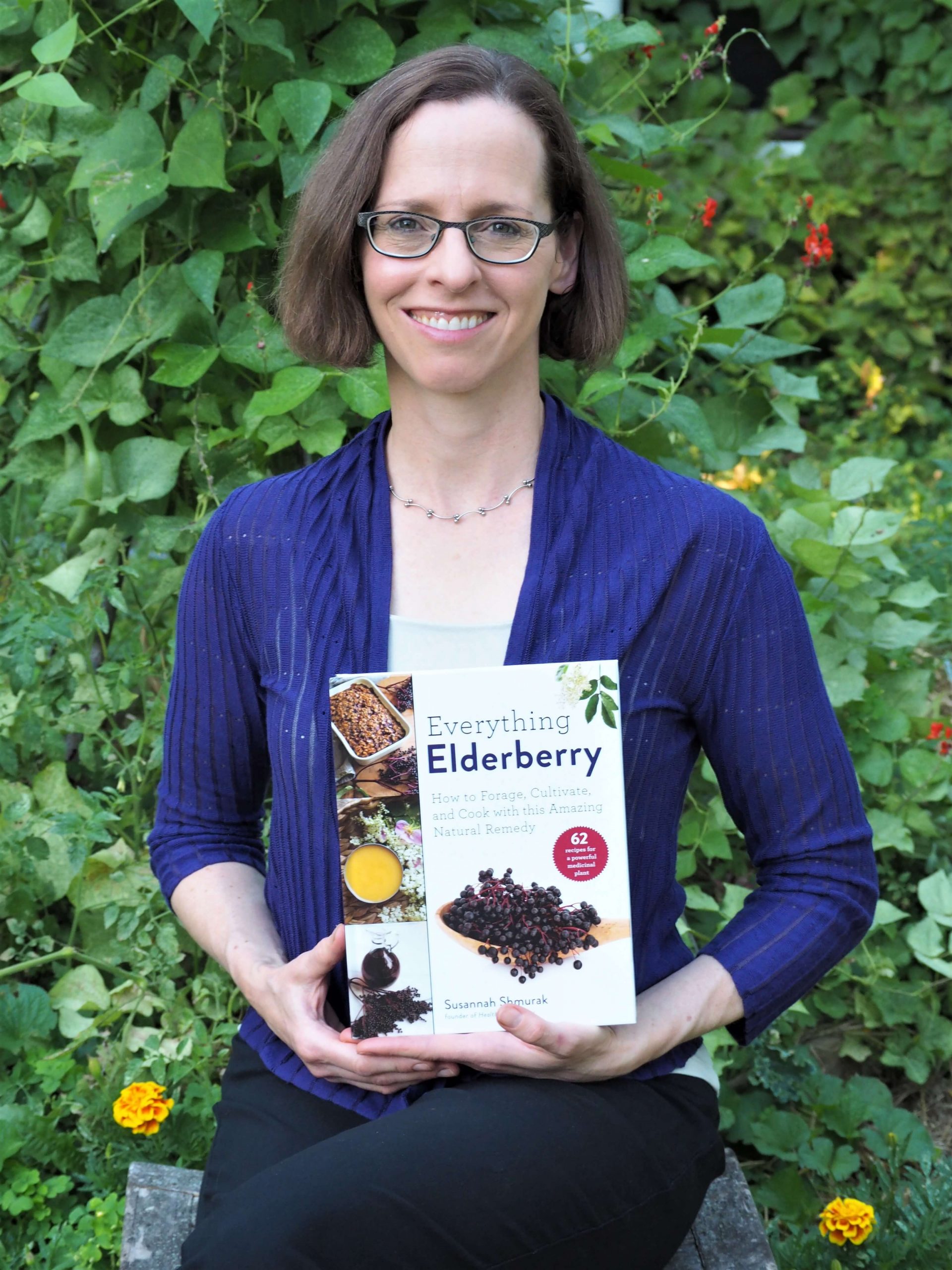Last Updated on May 19, 2023
Spruce tips are a tasty foraged ingredient that are easy to find and abundant for a short time in mid to late spring. Here’s what to know about foraging spruce tips and what to do with them.
If you’re one of the many people who didn’t know about the free food growing on trees in your neighborhood long before the mulberries ripen, get ready to have some fun! Spruce tips are a delightful seasonal food worth getting to know.
ARE SPRUCE TIPS EDIBLE?
Spruce tips are indeed edible, as is much of the spruce tree. Spruce was a staple food source for Native Americans and is an excellent source of vitamin C.
Unlike spruce tea, which is awesome because you can forage it throughout the year, spruce tips are one of those spring delicacies we can get for a short period early in the growing season. These tender tips are the new growth of the spruce tree, and they can be used in numerous ways that capitalize on their bright, tangy flavor.
When spruce tips are at their most small and tender, you can nibble them on their own, though they’re more exciting and tasty used in recipes. You can use them as garnishes and in numerous cooked dishes, both sweet and savory.
We count the spruce tree growing in our edible landscape among the perennial vegetables we harvest from our mini permaculture food forest. There’s no shortage of other fantastic edible wild plants growing there as well, including cleavers, yarrow, dandelion, and purslane.
IDENTIFYING & FORAGING SPRUCE TIPS
You have to be on the ball to catch the tips before they develop into mature parts of the tree, though if you’re too late, you can always brew your more mature spruce into tea.
Keep your eyes open for the first bright green growth happening at the end of spruce tree branches. You’ll find that different trees will be further along in their growth than others depending on their growing conditions, so if one is a little past its prime, seek another in a shadier location and you’ll likely find the spruce tips you’re after. Different varieties also produce tips at different times, helping to extend the season as well.
You’ll see bright green needles at the end of the darker green branch (or bluish in the case of blue spruce). When you touch the tips, you’ll discover they’re soft and pliable in contrast to the harder, prickly needles of more mature spruce. You may find very small spruce tips, less than an inch long and sometimes still encased in a brown papery wrapping, or later on you’ll see green tips up to two inches long and more unfurled. You’ll often find both on the same tree.
The youngest, smallest spruce tips will be the most tender, but the larger ones before they start to toughen up are tasty, too. They might be a better choice for cooked rather than for uncooked dishes. Choose the most tender ones for raw uses.
How to identify spruce trees:
The first rule of foraging is to make sure you correctly identify your plant, as many plants have toxic cousins that can be mistaken for them. Always consult a good field guide before foraging any plant for the first time. Here are some of the best foraging books I’ve found.
There are also regional guides you can consult, or consider taking a foraging class, like the Herbal Academy’s online foraging course, which teaches plant identification and ethical wildcrafting practices.
It’s important you know what kind of tree you’re foraging from, since some types of conifer are toxic, such as the highly poisonous yew. (More on why you really want to avoid yew from Eat the Weeds here.)
Spruces have square rather than flat needles that attach to the branch individually. Yews have wide, flat, bendable needles, darker on top and lighter on bottom. Yews don’t produce cones, but have red fruit. Here’s a helpful video on identifying toxic yew.
Not sure which edible conifers are which? This tutorial on telling spruce vs fir vs pine should help you correctly identify them. Pine and fir are both edible also, by the way. Here’s how to make a simple but delicious pine needle tea and pine needle syrup, and here’s a post exploring that perennial winter foraging question, ‘Can you eat pine cones?’
Foraging Basics
Always choose trees that you know haven’t been near pesticide spray, so if they’re near a farm that sprays or on public lands that have been sprayed, it’s wiser to find somewhere cleaner.
Pick sparingly so you don’t harm the tree. Some sources suggest limiting yourself to a handful of tips per tree, while others suggest heavier harvesting from larger trees is OK. Be aware that wherever you remove tips, there won’t be any growth that year. Never pick from the top of the tree, or you’ll stunt its growth.
Picking from a larger tree means you’re less likely to overharvest and there’s no way you’re getting anywhere near the top of some of these majestic trees. They can grow really tall!
If you see three tips growing together, harvest from the sides rather than the center so the branch can continue growing outward. Harvesting from interior branches is another way to be sure you’re not harming the tree’s growth.
Different trees will taste slightly different, so you can sample tips from a number of different trees and choose your favorites. Some people prefer blue spruce, while others favor Norway or white.
As with all new-to-you foraged foods, start with a little to make sure you don’t have an adverse reaction. I’ve read that some people may be allergic to spruce.
STORING SPRUCE TIPS
Because you have a relatively short window of time to gather your spruce tips, it’s wise to pick a good amount and store them. Just don’t overharvest any one tree; pick a little from numerous trees till you have what you want.
Spruce tips keep well in the refrigerator in an airtight container. For longer storage, you can freeze or dehydrate them. Pickled spruce tips will also keep a long time.
USING SPRUCE TIPS
What to do with all those spruce tips? If you’ve gathered a lot, consider keeping some in the refrigerator or freezer for later use. Or allow them to dry, either on their own or with salt or sugar (instructions below).
If you’re new to the idea of eating spruce, you may be surprised to discover all the ways you can use them, from an easy garnish, to sweets, to cocktails.
My favorite way to use spruce tips is to toss them on salmon before baking. They take on a lovely herb-y flavor that some people liken to rosemary, though I think the flavor is quite different.
You can chop them up and sprinkle on salads. I used some this spring in a wild rice salad with homegrown chives and wild violet flowers, and it was fantastic!
Other simple ways to use your spruce tips:
- Add to roasted vegetables or meats as you would rosemary
- Sprinkle on green salads, or grain or legume salads
- Toss into smoothies
- Add chopped spruce tips to your favorite vinaigrette
- Make a spruce tip syrup to add to sparkling water or turn into sorbet
- Add chopped spruce tips to scones or shortbread
Some people dry their spruce tips for use in homemade cough syrups and herbal teas, but the mature spruce works for these purposes as well, so I generally like to put these ephemeral ingredients to other uses, where their tender green flavor adds a special sparkle.
You can dry ground spruce tips with sugar or salt to make a flavorful topping for vegetable dishes or baked goods.
You can make spruce tips infused vinegar by steeping spruce tips in vinegar and allowing it to infuse for about a month.
If you’re making spruce tip vinegar or spruce tip syrup, note that you get two recipes for one! When you strain out the tips, you keep both the liquid and the tips. The pickled spruce tips can be used as a vegetable, while the sweetened ones can be dried into a candied treat. Yum!
Find numerous ways to use your spruce tips in this roundup of spruce tip recipes and on my Pinterest board dedicated to recipes with foraged ingredients. I add more incredible ways to make the most of a wide array of foraged foods all year round on my Pinterest foraging board. Follow the board to keep learning about fantastic foods to forage in your neighborhood, like mulberries, purslane, dandelions, violets, creeping Charlie, Virginia waterleaf, garlic mustard, and so many more.
You can find loads more ways to use spruce tips and other edible conifers in a new book filled with recipes called How to Eat Your Christmas Tree.
Ever foraged spruce tips before? What are your favorite ways to use them?
If you’ve missed them this season, brew up some spruce tea with whatever spruce you find and pin to save this info on foraging spruce tips for next season!
–>Looking for more exciting foraged goodies this season? Keep your eyes out for elderflowers, honeysuckle, and juneberries, coming to a shrub near you very soon. Here are 25 serviceberry recipes if you find yourself with a big haul of these delicious fruits.
Pin to save this info on foraging spruce tips for later!
Spruce tips cover photo credit: Alexandr Ivanov

Susannah is a proud garden geek and energy nerd who loves healthy food and natural remedies. Her work has appeared in Mother Earth Living, Ensia, Northern Gardener, Sierra, and on numerous websites. Her first book, Everything Elderberry, released in September 2020 and has been a #1 new release in holistic medicine, naturopathy, herb gardening, and other categories. Find out more and grab your copy here.




 Hi, I'm Susannah, a garden geek, energy nerd, and fan of healthy food and natural remedies. Need some simple, practical solutions for living healthier and greener? You've come to the right place! More about me and my green projects
Hi, I'm Susannah, a garden geek, energy nerd, and fan of healthy food and natural remedies. Need some simple, practical solutions for living healthier and greener? You've come to the right place! More about me and my green projects
Leave a Reply